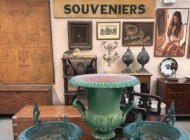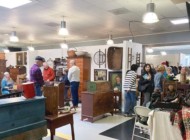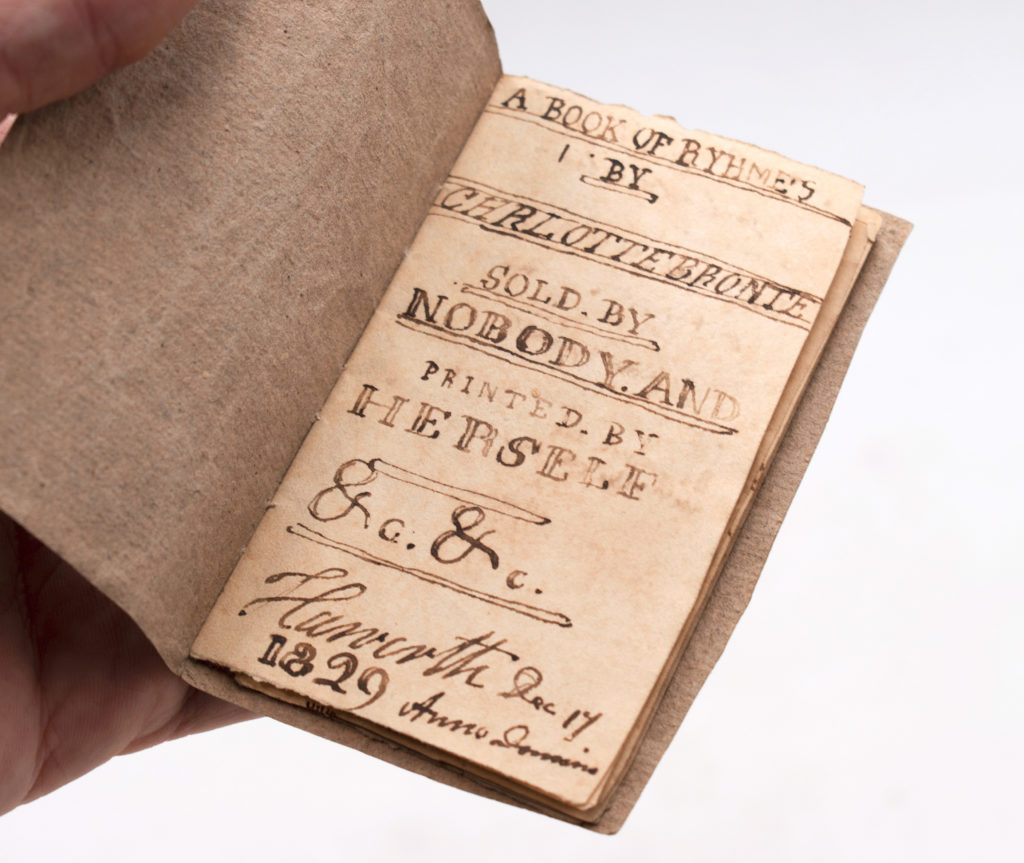
Review and Onsite Photos by Madelia Hickman Ring
NEW YORK CITY – From April 21-24, 182 exhibitors from four continents, specializing in every genre and vintage of books, manuscripts, maps, documents, ephemera and anything that could be considered even remotely related returned to the Park Avenue Armory for the 62nd Annual New York International Antiquarian Book Fair (NYIABF). Skipping just one year – 2021 – because of the pandemic, vendors were nonetheless happy to return and many reported a brisk trade, with some rating this edition among the best in the show’s history.
Sanford Smith, the fair’s long-time manager, was pleased with how the show turned out.
“According to most dealers, it was the best book fair we’ve ever had. For a number of years, many have said it’s the best antiquarian book fair in the world and we had some unbelievable sales.”
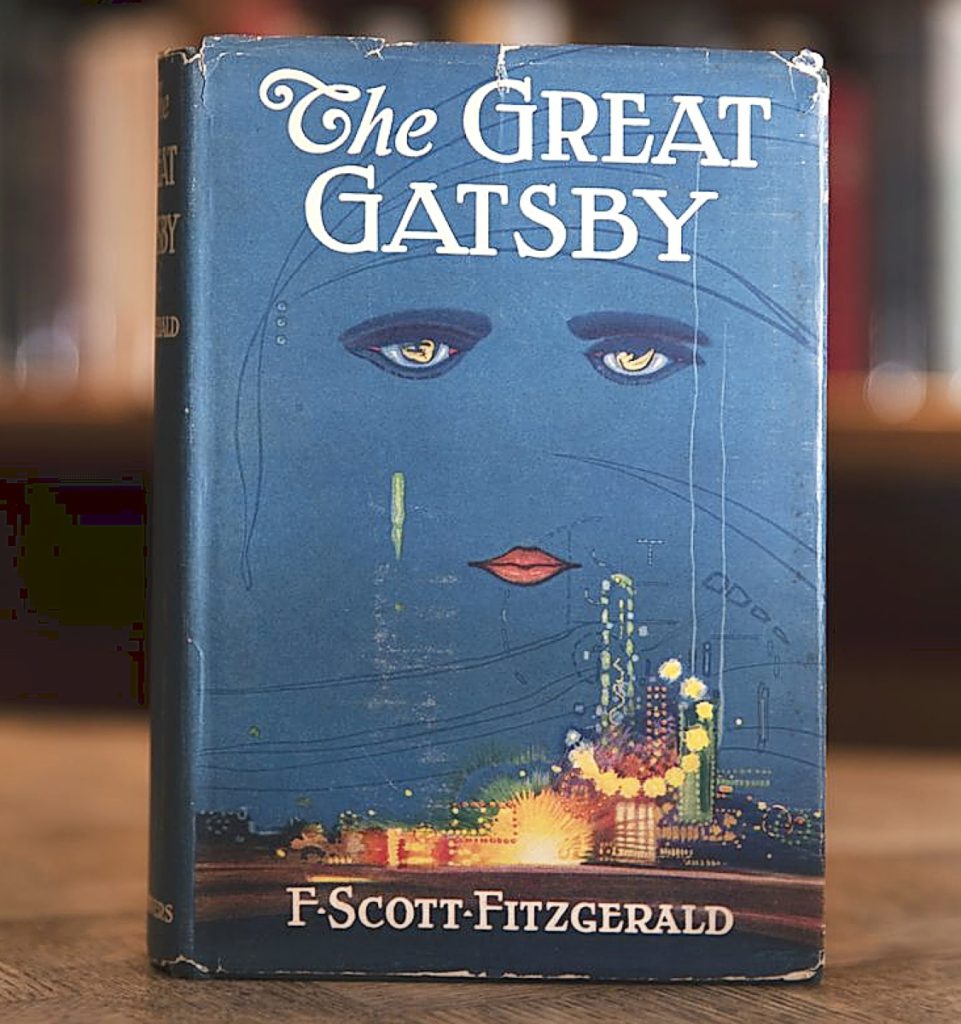
Smith populates the drill floor of the armory with three different categories of dealers, from those who do it professionally, semiprofessionally, or those for whom it is a part-time endeavor. Visitors can expect to find a broad range of values, from $25 or $50 to seven figures, but because the fair is sanctioned by the Antiquarian Booksellers’ Association of America and the International League of Antiquarian Booksellers, visitors can buy with confidence knowing that any purchase, regardless of price point, has been guaranteed and presented in the most accurate manner possible.
A few changes distinguished this edition from previous ones. On a purely aesthetic note, Smith had increased the height of the side walls from three feet to eight feet tall, and had carpeting only on the booth interiors, leaving the aisles bare. There were a few new faces, but the field of vendors was notably smaller than previously, down from about 205 or 208. Smith attributed this to the several factors, including lingering concerns about Covid-19 among more senior exhibitors and the increased expense and freight time for international vendors.
If the floor saw fewer dealers, the gate was higher than it has been, a good 50 percent higher than it had been in 2020, Smith reported. Doubtless some of the enthusiasm could be chalked up to the excitement of returning to a live event after a long winter and even longer pandemic closeting but also in part, Smith thought, to how much people love the show.
-1024x566.jpg)
“They can stay all day and browse. There is the congeniality of talking with exhibitors, all of whom are experts and collectors want to talk to people who know what they are doing.”
One of the most talked about works at the fair was Charlotte Brontë’s A Book of Rhymes, referred to as the “Baby Brontë” because it fits easily in the palm of a small hand and was written in October 1829, when Brontë was 13 years old during her childhood at Haworth Parsonage. The manuscript was last seen in public in 1916 when Walpole Galleries, New York City, auctioned it. The tiny 15-page manuscript was signed by Brontë no less than 12 times and was the last of two dozen miniature books made by the young Brontë in private hands. Smaller than a playing card, the volume contains ten previously unpublished poems.
-1024x576.jpg)
Carefully ensconced in a glass case in the booth of New York City bookseller James Cummins, the volume had been priced at $1.25 million. After the show, it was revealed that the book sold to the Friends of the National Libraries, a British charity, which is donating the book to the Brontë Parsonage Museum in Haworth, Yorkshire. A press release issued by the museum quoted chief curator, Ann Dinsdale, as saying, “It is always emotional when an item belonging to the Brontë family is returned home, and this final little book coming back to the place where it was written after being thought lost is very special for us.”
Another work that attracted considerable media attention before the show, and sold for $2 million, was an archive of more than 700 historic wine reference books and manuscripts that dated back to the Sixth Century. Belonging to California winemaker Sean Thackrey and assembled over decades, the Thackrey Library is one of the world’s largest privately owned collections of wine texts; it includes a Sixth Century papyrus leaf from Egypt that records the sale of grapevines from a monastery to an Egyptian farmer, a Fifteenth Century edition of De Vinis by Arnaldus de Villanova, as well as several Sixteenth Century manuscripts previously owned by the writer and wine merchant, André Simon. The buyer was not disclosed.
-1024x576.jpg)
London dealer Peter Harrington reported three high-ticket sales, including a first edition of F. Scott Fitzgerald’s The Great Gatsby, which had been priced at $360,000. The 1925 volume, which was part of an original run of just 20,870 copies, was in original, untouched mint condition, a particular rarity given a past trend for restoring damaged editions. The volume was featured in an article written in advance of the fair that appeared in Bloomberg.
Harrington’s two other noteworthy sales were a leaf of the Gutenberg Bible, from the Mannheim copy, which New York book dealer Gabriel Wells divided into single leaves or larger fragments and inserted into a Morocco leather portfolio by Stikeman and Company. Rounding out his top trades was a Kelmscott Press 1896 copy of Geoffrey Chaucer’s The Works, one of 425 copies that was the result of a four-year collaboration between William Morris and Edward Burne-Jones. The volume is considered one of the most important books published by Kelmscott Press.
Americana and historical manuscripts dealer Seth Kaller had several enticing pieces in his small booth, including a Suffrage satin tricolor parade sash with provenance to the Cornelia Rose estate, a broadside titled “Some Account of the Bloody Deeds of General Jackson,” a copy of Paul Revere’s “Boston Massacre,” and an advance text of Martin Luther King’s “I Have A Dream” speech.
-1024x530.jpg)
Cincinnati, Ohio, dealer Ted Twyman of First Edition Rare Books was making his Antiquarian Book Fair debut and had an impressive White House Historical guide from 1962 that was signed by John Fitzgerald Kennedy, Jacqueline Kennedy and Caroline Kennedy. Barry Harlow’s 1970 White House photograph was signed by members of the White House staff, many of which were involved in Watergate, and he had a copy of Richard Nixon’s memoirs that was inscribed to John McCain’s father, John S. McCain Jr. Twyman said he had had a good show before it even opened, selling some Raymond Chandler books and presidential pieces during set up.
NYIABF encourages booksellers to stock a broad range of price points and you could find that without much difficulty. Brenner’s Books, Manasquan, N.J., fronted its booth with bookshelves prominently marked with books marked “$100 or less” to entice beginning collectors. Near the front, a framed circa 1942 Trader Vic’s menu from Oakland, Calif, was priced at $395.
David Lilburne, Antipodean Books, Maps and Prints of Garrison, N.Y., is president of the Ephemera Society of America and has been doing the NYIABF since 1985.
-623x1024.jpg)
“The show was excellent,” David Lilburne said after the show. “It was both better than we expected and better than in previous years, by a long shot. Trade was aggressive and the show was busy throughout the weekend. Both Friday and Saturday were jammed and while Sunday was a little less crowded, it was still busy. We sold our last item at 5:05 pm on Sunday evening and first thing Monday morning, I got a call from someone saying, ‘I’ll take [a Toulouse Lautrec poster].'”
Lilburne had a book of Chinese pith pictures in an album with heavily carved boards that he sold to a gentleman who is not in the China market but loved the carved boards and the color of the pith pictures. The same collector also purchased a large, limited edition of Edward Boynton’s History of West Point, which he purchased as a gift for a friend who attended West Point.
Lilburne’s proximity to West Point has led to business and personal relationships with several of the military academy’s staff, including Colonel Dave Harper, who is a professor and head of the department of English and Philosophy. Harper brings the academy’s Rare Book Club to Lilburne’s shop where they can handle books or takes them to a local publisher to see how books are made. One year, Harper asked Lilburne if he could bring his cadets to the armory show; Sanford Smith makes tickets possible so now, every year, about 15 cadets attend. This year, Lilburne said they came with two of the academy’s librarians.
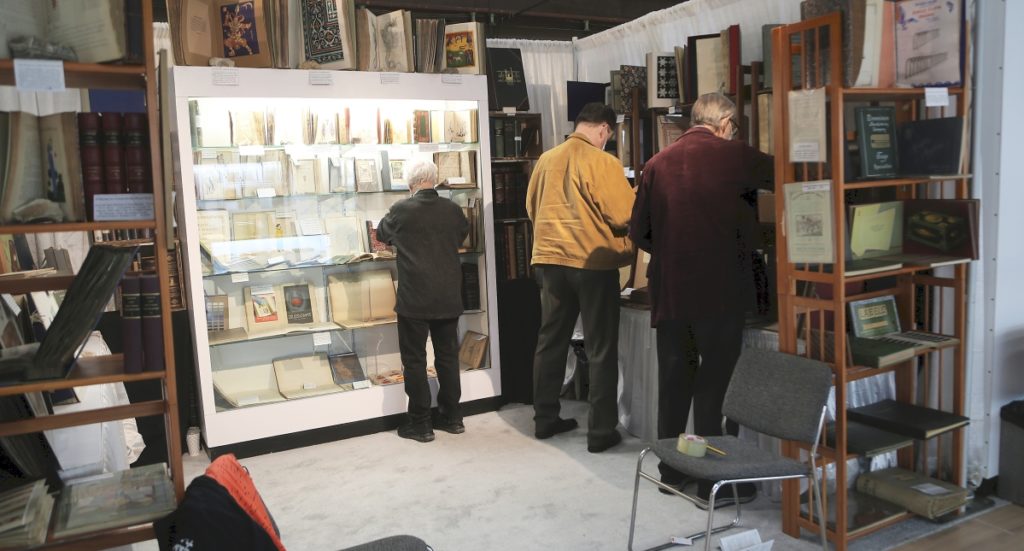
“I’m so happy to be here,” said Princeton, Mass., bookseller James Gray, who noted he took advantage of the pandemic lockdown to research and blog about his inventory, which focuses on early printed books. Among the things in his booth that he proudly showed off was the adaption of QR codes that people could scan that would bring up information about each work he was selling.
“I get alerts from the platform that hosts my blog that tells me how many ‘readers’ I have; on a good day, I see between 40 and 50 readers. Before 9 am on Saturday, I had 146 readers.”
“It was a very good show. I wrote twice as many invoices at that show as I have at any show I’ve ever done; to new and old clients, as well as institutions. I had some substantial purchases, too.” Gray said the level of attention was “much higher” than usual and he was pleased to see that younger people were also buying, with about half of his buyers being younger than him. He met people from all over, including a woman from Melbourne, Australia, who came to New York just to attend the fair. He made sales throughout the weekend, selling out of all his catalogs – a first for him – and in the last two hours of the show, he reported “nice sales to famous collectors, one from New York, the other from Washington.”
One of the sales Gray specified was A Sea Man’s Kalendar, which described navigational routes and would have been kept on board a ship for most of its life. Most were lost overboard or disintegrated from the elements, so it was a particularly rare survivor
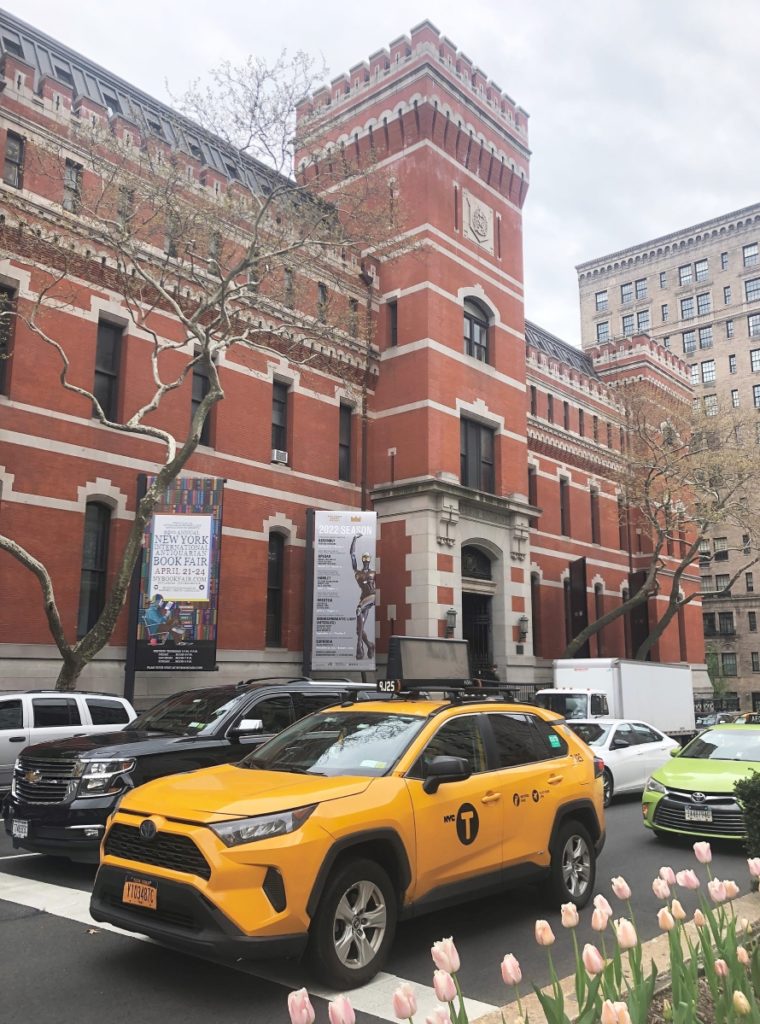
“It’s really cool because you can see cloth and tar, and lots of binding threads,” Gray point out. He sold it to a state university in the Midwest United States.
One of the younger dealers on the floor, Michael Jennings of Neatline Antique Maps, first did the NYIABF in 2020, before the pandemic so this was his second time exhibiting in New York, but he shows regularly in California and Europe. When asked why he started to focus on maps, he said he had trained as an archaeologist and had always loved them. Among the pieces he pointed out were a Belle Epoque travel poster for around the world travel. For earlier travel, he’d hung an entire wall with early maps.
After the fair, Jennings reported selling a 1535 map to a client who looked at it during the show and called him the following day to say he wanted it. He said he had at least one sale in the works.
“I think many people are very satisfied with how the fair has been managed. The set up was very well organized,” said Peter Blackman of White Fox Rare Books & Antiques. The New York City dealer characterized trade among dealers as “good.” After the fair closed, he said the energy was very much like previous New York book fairs and he thought that the expectation that visitors wear masks did not deter people from browsing. He saw strong institutional interest, though he thought attendance was down a bit because of Covid.
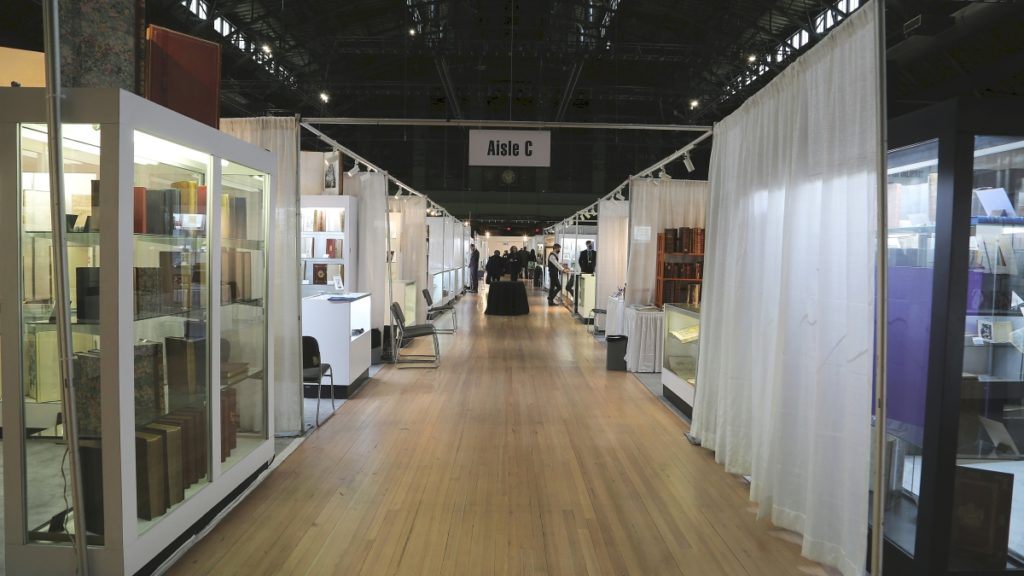
When we inquired as to what Blackman had that was very rare, he produced a “Gemalde auf Spinnengewebe” or painting on cobweb that was done by Franz Unterberger (Austria, 1838-1902) circa 1870s and depicted a young boy in Tyrolean garb, in a cardboard frame that measured about 5 by 4 inches. According to the dealer’s website, paintings on material woven from cobweb are quite scarce, with fewer than 100 paintings known to have been done. He had acquired it from a private collection.
One of Blackman’s sales was a set of four adorned engraved prints by Maerten de Vos (1532-1603), which featured Seventeenth Century prints with fabric woven into the paper in the Eighteenth Century. The prints were religious subjects and Blackman said they were scarce, with the Victoria & Albert Museum being one of the only other places to have them. The set sold to a university library in the United States.
Occupying a large booth in the center of the drill floor was Bauman Rare Books. Among the treasures on offer with the Madison Avenue booksellers and priced at $16,500 was a rare Elizabeth I royal wax seal that had been discovered in a collection of Elizabethan ephemera. The seal was affixed by a ribbon to a single page of vellum granting in a secretarial hand the office of sheriff of the County Palatine of Chester to Thomas Aston, Esq.
-677x1024.jpg)
Of later vintage but also with Bauman was a presentation copy of Albert Einstein’s Relativity, The Special and General Theory, published in 1931 in New York City. The octavo volume in gilt-stamped navy cloth was inscribed with a rare inscription in Einstein’s characteristic tiny handwriting “Für Herrn. J.M. Frankel, Albert Einstein, 1933.” Bauman was asking $35,000 for it.
An Ernest Hemingway family archive with Stuart Lutz received a lot of attention. The group, which he had priced at $200,000, included letters written to his favorite sister Ursula and more than two letters between Ernest and his wife, Mary, written at the time of his suicide. The archive was being sold on behalf of Ursula’s family and had never been offered for sale previously. Of the 51 pieces, which were written between 1908 and 1966, 32 were written by Ernest and topics range from his writing and books to travel, awards, life in Cuba and his family and that of Ursula.
The 2020 NYIABF had been so outstanding for Lutz that this edition paled a little in comparison though he qualified it as “OK.” He appreciates the traffic it gets on Sundays and said he was in negotiations with an institution on the Hemingway archive that, if it goes through, would make the 2022 edition “wonderful.”
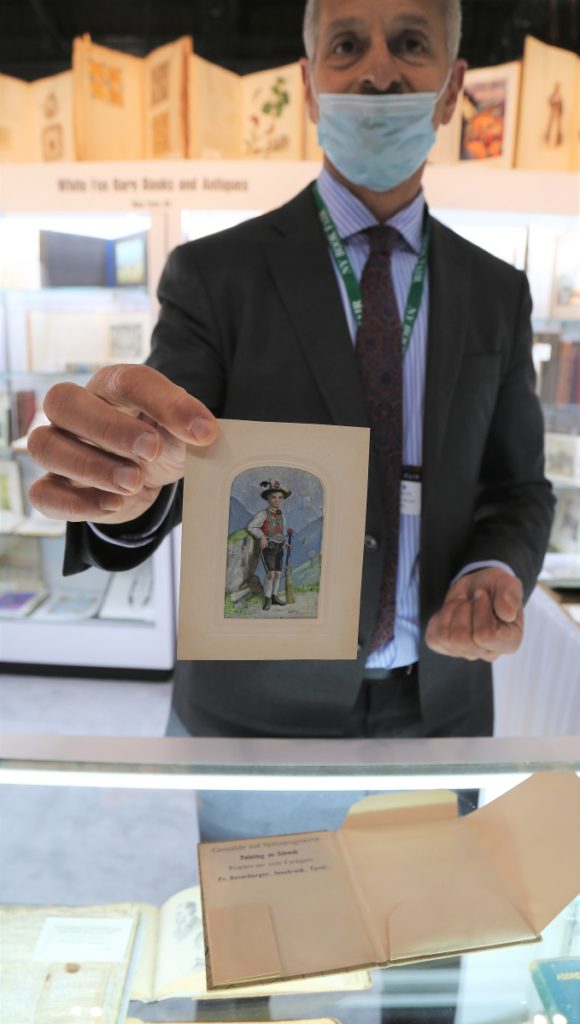
Triolet Rare Books specializes in modern literature and avant-garde movements with a focus on poetry, modernism, surrealism, fine printing and the lives of artists. Jesse Rossa had a drawing and two books by Leonora Carrington, as well as works by Leonor Fini, Max Ernst and James Joyce.
In the booth of Athena Rare Books, Fairfield, Conn., Lucy Rose DaSilva was briefly home before her final months as a senior at University of California Santa Cruz, where she is majoring in the history of consciousness. Her path of study aligns with the inventory of her family’s booth, which specializes in the history of ideas, philosophy, poetry, science, psychology and women philosophers. She has been helping her parents since she was 14 years old and recently oversaw a West Coast book fair entirely on her own.
“We sold a boatload of books,” DaSilva’s father, William “Bill” Schaberg, said after the fair, noting that while they didn’t sell any of the five-figure books they’d brought, they wrote about 25 invoices. At previous fairs, he said it was more common for them to sell one or two “really expensive books.” One of the sales he specified was a first edition copy of T.S. Eliot’s The Waste Land, which a trade buyer purchased.
“As long as people read, you’ll have book fairs,” Smith said. While he couldn’t specify the dates for the 2023 NYIABF – the fair is somewhat at the mercy of the scheduling and availability of the armory – information on future events can be found at www.nyantiquarianbookfair.com.

.jpg)
.jpg)

.jpg)





.jpg)

.jpg)


.jpg)

.jpg)
.jpg)
.jpg)
.jpg)
.jpg)


.jpg)


.jpg)
.jpg)



.jpg)
.jpg)
.jpg)
.jpg)

.jpg)



